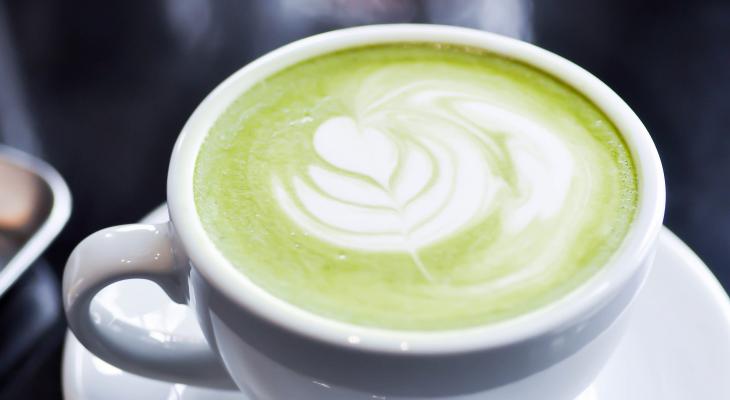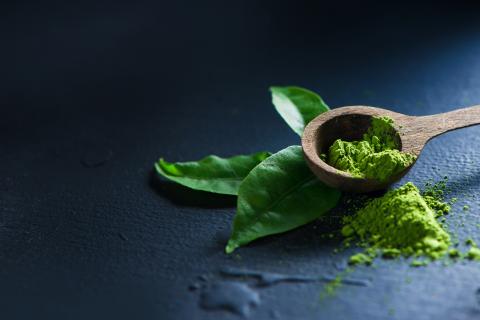Posted by Emily Steele Caitlin Mellendorf

March 12, 2020
I’m a big tea drinker – chai, green jasmine, oolong – you name it, I probably have a secret stash of loose leaf squirreled away. And just in time for St. Patrick’s Day and all things green, I’ve recently succumbed to matcha madness.
While matcha is traditionally used in Japanese tea ceremonies, this powdered tea has been making its way onto coffee shop menus as green tea lattes and into baked goods for color and flavor. Check out our Matcha Yogurt Bowl and a Green Tea Matcha Latte recipes below!
Matcha is dried tea leaves that have been finely ground into a bright green powder. Instead of steeping, like bagged or loose-leaf tea, matcha powder is mixed with water making the tea more flavorful, with smooth grassy undertones.

About Tea
In 2018, Americans drank more than 3.8 billion gallons of tea. After water, tea is the most widely consumed beverage around the world. Tea is an infusion of the leaves picked from the Camellia sinensis plant. How those leaves are processed determines if it’s a white, green, or black tea. Herbal “teas” tisanes - include chamomile, yerba mate, mint and rooibos.
Health Benefits
Tea leaves have zero calories and are packed with a variety of flavonoids, also well known as antioxidants. Of all teas, green tea has the most antioxidants, which protect your cells against damage. Teas also have caffeine, but coffee is still king in the stimulant arena. An 8 oz. cup of green tea has 9-63 mgs of caffeine, while coffee has 72-130 mgs.
There is a lot of research on the health benefits of tea for preventing cancers, diabetes, and obesity and improving cognitive function. Just a few examples include enhancing fat oxidation during exercise and reducing stress and anxiety, There is no hard and fast rule of how much of which tea will give you the most benefits, but a review of tea research confirms that consistently drinking tea is good for your health.
Ways to use matcha
Matcha tea is a great ingredient for letting your imagination run wild. A simple place to start is by adding it to a breakfast smoothie or to a vinaigrette salad dressing. Its bright green color makes it a natural alternative to food dye and you can use it to add color to oatmeal, pancakes and cookies. I’ve even found a matcha hummus recipe if you’re feeling brave!
Matcha comes in different grades, with varying price ranges.
Ceremonial: Highest quality, used for tea ceremonies.
Premium: Daily drinking.
Culinary: Least expensive, used for baking, desserts, etc.
You can find matcha online, in health food stores and grocery stores in the tea sections. It traditionally comes in air-tight tins or pouches, but single-serving packets have also recently hit the shelves. Store matcha and other teas in a dry, dark cabinet.
Matcha Yogurt Bowl
Print recipe
This green, white and orange yogurt bowl is the perfect breakfast tribute to the Irish flag for St. Patrick's Day. It can even work as a healthy dessert! If you're not a fan of coconut, substitute almond slivers. Any yogurt will work, but for more protein, try Greek yogurt, and read the label to avoid added sugars. Make it for yourself or share with a friend!
1 cup plain or vanilla yogurt
1 tsp matcha powder
1 orange or mandarin, peeled, deseeded and sliced
1/3 cup unsweetened shredded coconut
Wash hands.
Add yogurt to a bowl and stir in matcha powder. Mix thoroughly.
Top with orange slices and coconut and serve immediately.
Nutritional information: Serves 1. Per serving (calculated with low-fat vanilla yogurt and 1 medium orange): 450 calories, 21g total fat (18g saturated fat), 170mg sodium, 56g carbohydrate, 7g fiber, 17g protein.
Matcha Latte
Print recipe Video
A lot of green tea lattes at coffee chains are high in sugar and calories. To get the most health benefits, use this basic starter recipe to make your own creamy, single-serving latte at home. Start with a small amount of sweetener and use whatever milk you like – dairy, almond, coconut, etc. You can use a regular whisk or electric milk frother to mix. Feel free to add additional flavors like vanilla, chocolate or chai. Pour over ice to enjoy cold.
1½ tsp matcha powder
2 Tbs hot water, boiled and left to cool for a few minutes
1-2 tsp honey, maple syrup, other dissolvable sweeteners
¾ cup hot milk
Wash hands.
Sift the matcha into a cup.
Add the hot water and whisk until there are no lumps.
Add honey.
Add milk. For a foamier latte, froth the milk with a whisk or electric frother.
Nutritional information: Serves 1. Per serving (calculated with 1 tsp honey and reduced-fat, 2% milk): 450 calories, 21g total fat (18g saturated fat), 170mg sodium, 56g carbohydrate, 7g fiber, 17g protein

No comments:
Post a Comment